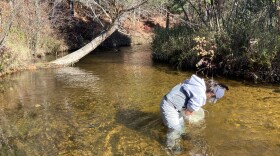You may have seen water slosh back and forth in a swimming pool or a bathtub the National Weather Service says that is a small scale seiche.
On a grander scale, they form when strong winds and rapid changes in the atmosphere push water from coast to coast. They can last for hours or even days.
This can happen with tsunamis, earthquakes or severe storm fronts right here on the Great Lakes.
One deadly event occurred in 1844, when a 22-foot seiche in Lake Erie breached a sea wall and killed 78 people. It dammed up ice to the extent that Niagara Falls temporarily stopped flowing.
Another seiche in Lake Michigan killed eight people in 1954. It formed during a violent squall in Michigan City and continued to build in size along the Illinois shoreline.
A 10-foot wave struck the North Avenue pier in downtown Chicago. Fishermen were swept off the pier, but some of them were rescued.
A witness to the storm described it as a “monstrous hump-backed sea beast” in the Chicago Tribune.
It can be rare for seiches of these sizes to occur, but smaller events happen all the time. A calmer seiche a few years formed on Lake Erie and captivated folks locally.
Lake Erie Living, a magazine, covered the event in its fall and winter issue.
The water level difference was about 20 feet from west to east. In cases like these, it can reveal the lake bottom.
A seiche can be majestic as it is dangerous. So the next time you witness a storm on the Great Lakes, keep an eye out for signs of a seiche — and keep your distance, too.







